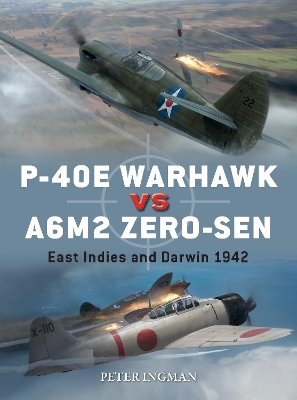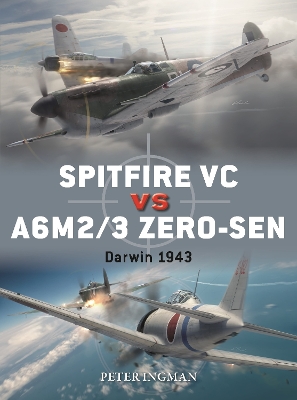Duel
1 primary work • 2 total works
Book 102
The P-40E Warhawk is often viewed as one of the less successful American fighter designs of World War II, but in 1942 the aircraft was all that was available to the USAAC in-theatre. Units equipped with the aircraft were duly forced into combat against the deadly A6M2 Zero-sen, which had already earned itself a near-mythical reputation following its exploits over China and Pearl Harbor. During an eight-month period in 1942, an extended air campaign was fought out between the two fighters for air superiority over the Javanese and then northern Australian skies. During this time, the P-40Es and the Zero-sens regularly clashed without interference from other fighter types. In respect to losses, the Japanese 'won' these engagements, for many more P-40Es were shot down than Zero-sens. However, the American Warhawks provided a potent deterrent that forced the IJNAF to attack from high altitudes, where crews' bombing efficiency was much poorer.
Fully illustrated throughout, and supported by rare and previously unpublished photographs, this book draws on both American and Japanese sources to tell the full story of the clashes between these iconic two fighters in Darwin and the East Indies.
Fully illustrated throughout, and supported by rare and previously unpublished photographs, this book draws on both American and Japanese sources to tell the full story of the clashes between these iconic two fighters in Darwin and the East Indies.
Just weeks after Pearl Harbor, Darwin was mauled by a massive Japanese attack. Without a single fighter to defend Australian soil, the Australian government made a special appeal to Britain for Spitfires.
A year later the Spitfire VC-equipped No 1 Fighter Wing, RAAF, faced the battle-hardened 202nd Kokutai of the IJNAF, equipped with A6M2 Zero-sens, over Darwin. This was a gruelling campaign between evenly matched foes, fought in isolation from the main South Pacific battlegrounds. Pilots on either side had significant combat experience, including a number of Battle of Britain veterans. The Spitfire had superior flight characteristics but was hampered by short range and material defects in the tropical conditions, while the Japanese employed better tactics and combat doctrine inflicting serious losses on the over-confident Commonwealth forces.
Fully illustrated with detailed full-colour artwork, this is the gripping story of two iconic aircraft facing off against each other above Australia.
A year later the Spitfire VC-equipped No 1 Fighter Wing, RAAF, faced the battle-hardened 202nd Kokutai of the IJNAF, equipped with A6M2 Zero-sens, over Darwin. This was a gruelling campaign between evenly matched foes, fought in isolation from the main South Pacific battlegrounds. Pilots on either side had significant combat experience, including a number of Battle of Britain veterans. The Spitfire had superior flight characteristics but was hampered by short range and material defects in the tropical conditions, while the Japanese employed better tactics and combat doctrine inflicting serious losses on the over-confident Commonwealth forces.
Fully illustrated with detailed full-colour artwork, this is the gripping story of two iconic aircraft facing off against each other above Australia.

